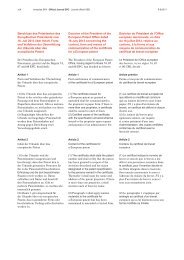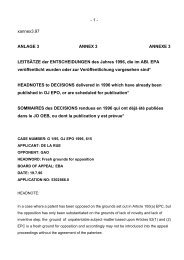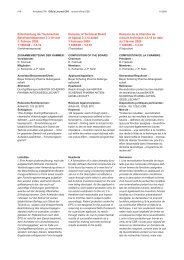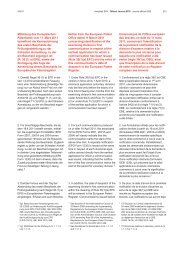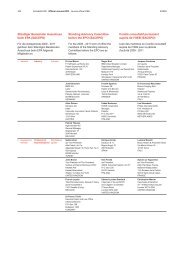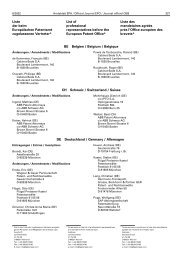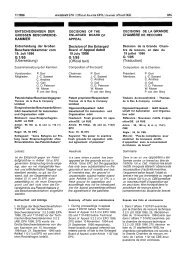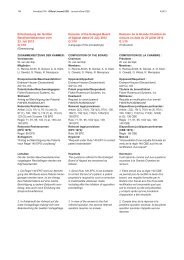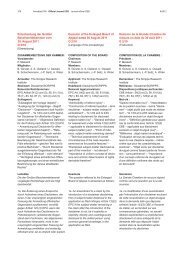laden - European Patent Office
laden - European Patent Office
laden - European Patent Office
Create successful ePaper yourself
Turn your PDF publications into a flip-book with our unique Google optimized e-Paper software.
148 Amtsblatt EPA / Official Journal EPO / Journal officiel OEB 3/2001<br />
MITTEILUNGEN DES EURO-<br />
PÄISCHEN PATENTAMTS<br />
Einspruchsverfahren im EPA<br />
Die nachstehende Darstellung ist eine<br />
Neufassung der im ABI. EPA 1989,<br />
417 ff. veröffentlichten Mitteilung<br />
über das Einspruchsverfahren vor<br />
dem EPA. Die Neufassung trägt der<br />
Weiterentwicklung des Einspruchsverfahrens<br />
durch Rechtsprechung<br />
und Praxis Rechnung.<br />
1. Allgemeine Grundsätze<br />
Das Europäische <strong>Patent</strong>amt ist<br />
bestrebt, im Interesse der am Einspruchsverfahren<br />
Beteiligten und der<br />
Öffentlichkeit möglichst rasch zu<br />
klären, ob und inwieweit das erteilte<br />
<strong>Patent</strong> im Hinblick auf das Einspruchsvorbringen<br />
aufrechterhalten<br />
werden kann. Dies soll insbesondere<br />
durch eine effiziente und straffe Führung<br />
des Verfahrens erreicht werden.<br />
Dabei sind die vor dem EPA geltenden<br />
allgemeinen Verfahrensgrundsätze<br />
und insbesondere das Prinzip<br />
des rechtlichen Gehörs (Artikel 113 (1)<br />
EPÜ) zu beachten.<br />
2. Zusammenfassende Darstellung<br />
des Verfahrens<br />
2.1 Verfahrensschritte, die je nach<br />
Sachlage vor oder nach Ablauf der<br />
Einspruchsfrist unternommen werden:<br />
2.1.1 Mitteilung der Einspruchsschrift<br />
an den <strong>Patent</strong>inhaber unmittelbar<br />
nach ihrem Eingang im EPA.<br />
2.1.2 Prüfung des Einspruchs auf<br />
Zulässigkeit.<br />
2.1.3 Aufforderung an den Einsprechenden,<br />
die angegebenen Unterlagen<br />
oder Beweismittel binnen zwei<br />
Monaten vorzulegen, soweit sie nicht<br />
bereits mit der Einspruchsschrift eingereicht<br />
worden sind (siehe Nr. 4.2).<br />
2.2 Verfahrensschritte nach Ablauf<br />
der Einspruchsfrist:<br />
2.2.1 Nach Prüfung der Zulässigkeit<br />
oder nach Ablauf der von der Einspruchsabteilung<br />
in einer Mitteilung<br />
nach Regel 56 (2) EPÜ oder der in<br />
einer Aufforderung nach Nr. 2.1.3<br />
gesetzten Frist (je nachdem, welche<br />
INFORMATION FROM THE<br />
EUROPEAN PATENT OFFICE<br />
Opposition procedure in the<br />
EPO<br />
The following is a revised version of<br />
the notice on the opposition procedure<br />
before the EPO published in<br />
OJ EPO 1989, 417 ff. It reflects the<br />
further developments in opposition<br />
procedure that have come about in<br />
the light of case law and practice.<br />
1. General principles<br />
The EPO’s aim is to establish as<br />
rapidly as possible, in the interest of<br />
both the public and the parties to<br />
opposition proceedings, whether,<br />
and to what extent, a patent may be<br />
maintained on the basis of an opponent’s<br />
submissions. In particular the<br />
EPO seeks to achieve this by means<br />
of an efficient and streamlined procedure.<br />
At the same time, the general<br />
principles governing the procedure<br />
before the EPO and in particular<br />
the principle of the right to be<br />
heard (Article 113(1) EPC) must be<br />
respected.<br />
2. Summary of the procedure<br />
2.1 Procedural steps taken before or<br />
after expiry of the opposition period,<br />
depending upon the facts of the case:<br />
2.1.1 Communication of a notice of<br />
opposition to the patent proprietor,<br />
immediately after its filing at the<br />
EPO.<br />
2.1.2 Examination of an opposition<br />
for admissibility.<br />
2.1.3 Invitation to the opponent to<br />
furnish within two months the cited<br />
documents or evidence, if not<br />
already submitted with the notice of<br />
opposition (see point 4.2 below).<br />
2.2 Procedural steps taken after<br />
expiry of the opposition period:<br />
2.2.1 After examination for admissibility<br />
or after expiry of the time limit<br />
set by the opposition division in a<br />
communication under Rule 56(2) EPC<br />
or of the time limit set in the invitation<br />
referred to in point 2.1.3 above<br />
COMMUNICATIONS DE<br />
L’OFFICE EUROPEEN DES<br />
BREVETS<br />
La procédure d’opposition à<br />
l’OEB<br />
Le texte qui suit est une nouvelle version<br />
de l’exposé sur la procédure<br />
d’opposition paru au JO OEB 1989,<br />
417 s. Cette version tient compte du<br />
développement de la procédure<br />
d’opposition, suivant la jurisprudence<br />
et la pratique.<br />
1. Principes généraux<br />
L’<strong>Office</strong> européen des brevets<br />
s’efforce, tant dans l’intérêt du public<br />
que de celui des parties à la procédure<br />
d’opposition, d’établir le plus<br />
rapidement possible si, et dans<br />
quelle mesure, le brevet délivré peut<br />
ou non être maintenu au vu des<br />
moyens invoqués par l’opposant.<br />
Pour cela il faut notamment une procédure<br />
efficace et rationalisée. A cet<br />
égard, les principes généraux de procédure<br />
en vigueur à l’OEB, en particulier<br />
le principe du fondement des<br />
décisions (article 113(1) CBE), doivent<br />
être observés.<br />
2. Résumé de la procédure<br />
2.1 Actes de procédure accomplis,<br />
selon le cas, avant ou après l’expiration<br />
du délai d’opposition :<br />
2.1.1 Notification au titulaire du brevet<br />
de l’acte d’opposition dès sa<br />
réception par l’OEB.<br />
2.1.2 Examen de la recevabilité de<br />
l’opposition.<br />
2.1.3 Invitation à l’opposant à produire<br />
dans un délai de deux mois les<br />
documents ou les moyens de preuve<br />
indiqués, dans la mesure où ils n’ont<br />
pas déjà été produits avec l’acte<br />
d’opposition (voir point 4.2).<br />
2.2 Actes de procédure devant être<br />
accomplis après l’expiration du délai<br />
d’opposition :<br />
2.2.1 Après l’examen de la recevabilité<br />
ou à l’expiration du délai imparti<br />
par la division d’opposition dans la<br />
notification prévue à la règle 56(2)<br />
CBE ou dans l’invitation mentionnée<br />
au point 2.1.3 (le délai à retenir est
3/2001 Amtsblatt EPA / Official Journal EPO / Journal officiel OEB 149<br />
Frist später abläuft) wird der <strong>Patent</strong>inhaber<br />
aufgefordert, innerhalb einer<br />
bestimmten Frist (normalerweise vier<br />
Monate) Stellung zu nehmen (insbesondere<br />
zu den vorgebrachten Tatsachen,<br />
Beweismitteln und Argumenten)<br />
und gegebenenfalls Änderungen<br />
seines <strong>Patent</strong>s einzureichen (Regel<br />
57 (1) EPÜ).<br />
2.2.2 Die Stellungnahme des <strong>Patent</strong>inhabers<br />
und etwaige Änderungen<br />
des <strong>Patent</strong>s werden dem Einsprechenden<br />
unverzüglich mitgeteilt<br />
(Regel 57 (3) EPÜ).<br />
Hat der <strong>Patent</strong>inhaber in Beantwortung<br />
des Einspruchsschriftsatzes<br />
geänderte <strong>Patent</strong>unterlagen eingereicht,<br />
so enthält diese Mitteilung<br />
auch eine Aufforderung zur Stellungnahme<br />
innerhalb einer Frist von in<br />
der Regel vier Monaten (vgl. Richtlinien<br />
D-IV, 5.4 Absatz 1). Wenn keine<br />
geänderten Unterlagen eingereicht<br />
werden, wird die Einspruchserwiderung<br />
dem Einsprechenden zur Kenntnisnahme<br />
übersandt.<br />
Haben sowohl der <strong>Patent</strong>inhaber als<br />
auch der Einsprechende eine mündliche<br />
Verhandlung beantragt, so wird<br />
die Stellungnahme des <strong>Patent</strong>inhabers,<br />
auch wenn er Änderungen vorgenommen<br />
oder beantragt hat, dem<br />
Einsprechenden lediglich zur Kenntnisnahme<br />
übersandt. Die Akte wird<br />
unverzüglich der Einspruchsabteilung<br />
zugeleitet, die über das weitere Verfahren<br />
entscheidet (z. B. Festsetzung<br />
eines Termins für die mündliche Verhandlung<br />
oder Aufforderung an die<br />
Beteiligten, weitere Stellungnahmen<br />
einzureichen).<br />
2.3 Weiteres Verfahren<br />
2.3.1 Hält die Einspruchsabteilung im<br />
Verlauf des Verfahrens eine weitere<br />
Klärung der Sachlage oder eine Stellungnahme<br />
eines Beteiligten zum<br />
Vorbringen der Gegenpartei für erforderlich,<br />
so wird der betreffende Beteiligte<br />
aufgefordert, sich innerhalb<br />
einer bestimmten Frist (in der Regel<br />
vier Monate) zu dem Vorbringen zu<br />
äußern (vgl. Richtlinien D-VI, 3.1).<br />
2.3.2 Hat ein Verfahrensbeteiligter<br />
eine mündliche Verhandlung beantragt<br />
oder hält die Einspruchsabteilung<br />
selbst eine mündliche Verhandlung<br />
für sachdienlich, so wird ein<br />
Termin für eine mündliche Verhandlung<br />
anberaumt (Einzelheiten zur<br />
mündlichen Verhandlung siehe Nr. 9).<br />
2.3.3 Findet keine mündliche Verhandlung<br />
statt und ist keine weitere<br />
Sachaufklärung erforderlich (d. h. die<br />
Entscheidung kann auf Gründe<br />
(whichever is the later), the patent<br />
proprietor is invited to file within a<br />
specified period (usually four<br />
months) his observations (in particular<br />
on the facts, evidence and<br />
arguments submitted) and any<br />
amendments to the patent (Rule 57(1)<br />
EPC).<br />
2.2.2 The observations and any<br />
amendments filed by the patent<br />
proprietor are immediately<br />
communicated to the opponent<br />
(Rule 57(3) EPC).<br />
If the patent proprietor responds to<br />
the notice of opposition by filing<br />
amended patent documents, the<br />
communication to the opponent also<br />
invites him to comment within a<br />
specified period (normally four<br />
months; see Guidelines for Examination<br />
in the <strong>European</strong> <strong>Patent</strong> <strong>Office</strong>,<br />
D-IV, 5.4, first paragraph). If the<br />
proprietor does not file amended<br />
documents, his observations are<br />
forwarded for information to the<br />
opponent.<br />
If both the patent proprietor and the<br />
opponent request oral proceedings,<br />
the proprietor’s observations – even<br />
if amendments have been made or<br />
requested – are sent to the opponent<br />
purely for information. The dossier is<br />
forwarded immediately to the opposition<br />
division, which will decide<br />
how the procedure is to continue (eg<br />
fixing a date for the oral proceedings<br />
or inviting the parties to file further<br />
observations).<br />
2.3 Subsequent procedure<br />
2.3.1 If, during the course of the procedure,<br />
the opposition division considers<br />
it necessary to seek further<br />
clarification of the facts or to hear<br />
one party’s observations on the submissions<br />
of another party, the party<br />
concerned will be invited to comment<br />
on the submissions within a specified<br />
period (normally four months) (see<br />
Guidelines D-VI, 3.1).<br />
2.3.2 If oral proceedings are<br />
requested by one of the parties or<br />
considered expedient by the opposition<br />
division itself, a date for oral proceedings<br />
is fixed (for further information<br />
on oral proceedings, see point 9<br />
below).<br />
2.3.3 If no oral proceedings are to be<br />
held and if no further clarification of<br />
the facts is necessary (ie the decision<br />
can be based on grounds on which<br />
celui qui expire le dernier), le titulaire<br />
du brevet est invité à présenter ses<br />
observations (en particulier sur les<br />
faits et justifications avancés) et à<br />
soumettre éventuellement des modifications<br />
de son brevet dans un délai<br />
donné (normalement quatre mois)<br />
(règle 57(1) CBE).<br />
2.2.2 Les observations du titulaire du<br />
brevet ainsi que toutes modifications<br />
du brevet qu’il a soumises sont notifiées<br />
sans délai à l’opposant (règle<br />
57(3) CBE).<br />
Si, dans sa réponse à l’acte d’opposition,<br />
le titulaire du brevet a produit<br />
des pièces du brevet modifiées, la<br />
notification adressée à l’opposant<br />
contient également une invitation à<br />
présenter des observations dans un<br />
délai qui est en règle générale de<br />
quatre mois (Directives D-IV, 5.4, premier<br />
paragraphe). Si le titulaire du<br />
brevet n’a pas produit de pièces<br />
modifiées, sa réponse est transmise<br />
pour information à l’opposant.<br />
Lorsqu’une procédure orale est<br />
requise tant par le titulaire du brevet<br />
que par l’opposant, les observations<br />
du titulaire du brevet sont simplement<br />
transmises pour information à<br />
l’opposant, même s’il a effectué ou<br />
requis des modifications. Le dossier<br />
est immédiatement transmis à la division<br />
d’opposition qui décide de la<br />
suite de la procédure (elle fixe par<br />
exemple une date pour la procédure<br />
orale, ou invite les parties à présenter<br />
d’autres observations).<br />
2.3 Suite de la procédure<br />
2.3.1 Si, au cours de la procédure, la<br />
division d’opposition estime que la<br />
situation doit encore être clarifiée ou<br />
que l’une des parties doit présenter<br />
des observations sur les moyens<br />
invoqués par la partie adverse, la partie<br />
concernée est invitée à prendre<br />
position dans un délai déterminé (en<br />
règle générale, quatre mois) sur lesdits<br />
moyens (Directives D-VI, 3.1).<br />
2.3.2 Lorsqu’une partie à la procédure<br />
requiert une procédure orale<br />
ou que la division d’opposition ellemême<br />
la juge utile, une date est fixée<br />
pour la procédure orale (voir les<br />
détails concernant la procédure orale<br />
sous le point 9).<br />
2.3.3 Lorsqu’il n’a pas été demandé<br />
de procédure orale et qu’il n’est plus<br />
nécessaire de clarifier la situation (la<br />
décision pouvant donc se fonder sur
150 Amtsblatt EPA / Official Journal EPO / Journal officiel OEB 3/2001<br />
gestützt werden, zu denen sich die<br />
Beteiligten äußern konnten (Artikel<br />
113 (1) EPÜ)), wird unmittelbar über<br />
den Einspruch entschieden.<br />
2.4 Abschluß des Verfahrens<br />
Das Verfahren wird in jedem Fall mit<br />
einer Entscheidung abgeschlossen<br />
(Artikel 102 EPÜ).<br />
Ist der <strong>Patent</strong>inhaber an der Aufrechterhaltung<br />
des <strong>Patent</strong>s nicht mehr<br />
interessiert, so kann er den Widerruf<br />
des <strong>Patent</strong>s beantragen. Das <strong>Patent</strong><br />
wird dann widerrufen, weil keine<br />
vom <strong>Patent</strong>inhaber gebilligte Fassung<br />
vorliegt (Artikel 113 (2) EPÜ).<br />
Dasselbe gilt, wenn der <strong>Patent</strong>inhaber<br />
gegenüber dem EPA erklärt, daß<br />
er für alle benannten Vertragsstaaten<br />
auf das <strong>Patent</strong> verzichtet.<br />
Wird der Einspruch zurückgezogen,<br />
so kann das Verfahren durch Entscheidung<br />
der Einspruchsabteilung<br />
eingestellt werden (siehe hierzu<br />
Nr. 8.2).<br />
3. Mehrere Einsprechende<br />
Werden gegen das europäische<br />
<strong>Patent</strong> mehrere Einsprüche eingelegt,<br />
so werden sie gemeinsam behandelt.<br />
Die Einspruchsschriftsätze und alle<br />
späteren Schriftsätze der Beteiligten<br />
werden jeweils allen anderen Beteiligten<br />
übersandt oder zugestellt.<br />
Im folgenden werden einige wichtige<br />
Aspekte des Verfahrens näher erläutert.<br />
4. Einspruchsschrift und Stellungnahme<br />
des <strong>Patent</strong>inhabers<br />
4.1 Es wird empfohlen, für den Einspruch<br />
das Formblatt 2300 zu verwenden<br />
(auch über ”http://<br />
www.european-patent-office.org”<br />
verfügbar). Die Einspruchsschrift<br />
kann auch per Fax eingereicht<br />
werden.<br />
Der Einsprechende sollte mit der Einspruchsschrift<br />
auch alle relevanten<br />
Unterlagen einschließlich Kopien<br />
neuer Entgegenhaltungen (auch<br />
wenn diese in der EPA-Dokumentation<br />
vorhanden sind), Übersetzungen<br />
von Unterlagen, die nicht in einer<br />
Amtssprache des EPA abgefaßt sind,<br />
und nach Möglichkeit Kopien der in<br />
der Einspruchsschrift angegebenen<br />
weiteren Beweismittel einreichen.<br />
Regel 56 (1) EPÜ bestimmt, welche<br />
Erfordernisse innerhalb der Einspruchsfrist<br />
erfüllt sein müssen.<br />
the parties have had an opportunity<br />
to comment (Article 113(1) EPC)),<br />
the opposition will be decided on<br />
immediately.<br />
2.4 Closure of proceedings<br />
The proceedings will be concluded in<br />
every case with a decision (Article<br />
102 EPC).<br />
If the patent proprietor no longer<br />
wishes to maintain the patent, he can<br />
request that the patent be revoked.<br />
The patent is then revoked because<br />
no text approved by the proprietor is<br />
available (Article 113(2) EPC). The<br />
same applies if the proprietor<br />
informs the EPO that he surrenders<br />
(or abandons or renounces) the<br />
patent in respect of all the designated<br />
contracting states.<br />
If the opposition is withdrawn, the<br />
opposition division can terminate the<br />
proceedings by means of a decision<br />
(see point 8.2 below).<br />
3. Multiple opponents<br />
If several oppositions to a <strong>European</strong><br />
patent are filed, they will be considered<br />
jointly. The notices of opposition<br />
and all further submissions made by<br />
individual parties will be sent or<br />
notified to all other parties.<br />
Some important aspects of the procedure<br />
are considered in more detail<br />
below.<br />
4. The notice of opposition and reply<br />
of the proprietor<br />
4.1 Opponents are recommended to<br />
use Form 2300 (also available at<br />
http://www.european-patentoffice.org).<br />
The notice of opposition<br />
may also be filed by fax.<br />
Opponents should also file, with the<br />
notice of opposition, all relevant<br />
papers including copies of new documents<br />
cited (even those available in<br />
the EPO documentation), translations<br />
of any documents not in an EPO official<br />
language, and, wherever possible,<br />
a copy of any further evidence<br />
indicated in the notice.<br />
Rule 56(1) EPC stipulates the requirements<br />
that must be satisfied within<br />
the opposition period.<br />
des motifs au sujet desquels les parties<br />
ont pu prendre position (article<br />
113(1) CBE)), une décision concernant<br />
l’opposition est immédiatement<br />
rendue.<br />
2.4 Clôture de la procédure<br />
La procédure se conclut dans tous<br />
les cas par une décision (article 102<br />
CBE).<br />
Si le titulaire du brevet ne souhaite<br />
plus maintenir le brevet, il peut en<br />
requérir la révocation. Le brevet est<br />
alors révoqué, car il n’existe pas de<br />
texte accepté par le titulaire du brevet<br />
(article 113(2) CBE). Il en est de<br />
même lorsque le titulaire du brevet<br />
déclare vis-à-vis de l’OEB qu’il<br />
renonce au brevet pour tous les Etats<br />
contractants désignés.<br />
Si l’opposition est retirée, il peut être<br />
mis un terme à la procédure par<br />
décision de la division d’opposition<br />
(voir à ce propos le point 8.2).<br />
3. Pluralité des opposants<br />
Lorsque plusieurs oppositions au<br />
brevet européen ont été formées,<br />
elles sont traitées conjointement. Les<br />
actes d’opposition et tous les documents<br />
des parties produits ultérieurement<br />
sont transmis ou notifiés à<br />
toutes les autres parties concernées.<br />
On examinera ci-après plus en détail<br />
certains aspects importants de la<br />
procédure.<br />
4. L’acte d’opposition et la réponse<br />
du titulaire du brevet<br />
4.1 Il est recommandé d’utiliser le formulaire<br />
2300 (également disponible<br />
sur l’Internet à l’adresse ”http://<br />
www.european-patent-office.org”)<br />
pour former opposition. L’acte<br />
d’opposition peut aussi être déposé<br />
par télécopie.<br />
L’opposant doit joindre à l’acte<br />
d’opposition toutes pièces pertinentes,<br />
y compris les copies des nouveaux<br />
documents cités (même ceux<br />
qui figurent dans la documentation<br />
de l’OEB), une traduction des documents<br />
rédigés dans une langue non<br />
officielle de l’OEB et, dans la mesure<br />
du possible, une copie de toutes<br />
autres justifications invoquées dans<br />
l’acte d’opposition.<br />
La règle 56(1) CBE définit les conditions<br />
auxquelles doit satisfaire l’acte<br />
d’opposition.
3/2001 Amtsblatt EPA / Official Journal EPO / Journal officiel OEB 151<br />
4.2 Nach Regel 55 c) EPÜ muss die<br />
Einspruchsschrift die ”Angabe” der<br />
zur Begründung vorgebrachten Tatsachen<br />
und Beweismittel enthalten.<br />
Der Einsprechende muß also mindestens<br />
einen Einspruchsgrund nach<br />
Artikel 100 EPÜ nennen und die zur<br />
Begründung vorgebrachten Tatsachen,<br />
Beweismittel und Argumente<br />
angeben. Ist dieses Erfordernis nicht<br />
erfüllt, so wird der Einspruch als<br />
unzulässig verworfen.<br />
Die angegebenen Beweismittel können<br />
auch nachgereicht werden. Für<br />
die Einreichung dieser Unterlagen<br />
wird dem Einsprechenden eine kurze<br />
Frist (zwei Monate) gewährt (siehe<br />
oben Nr. 2.1.3 sowie Richtlinien D-IV,<br />
1.2.2.1 v)).<br />
4.3 Der <strong>Patent</strong>inhaber sollte innerhalb<br />
der gesetzten Frist (siehe oben<br />
Nr. 2.2.1) zu dem Einspruch bzw. zu<br />
den Einsprüchen umfassend Stellung<br />
nehmen, also alle Tatsachen, Beweismittel<br />
und Argumente zur Begründung<br />
seines Standpunkts vorbringen.<br />
Falls erforderlich, sollte er geänderte<br />
Unterlagen vorlegen, um den geltend<br />
gemachten Einspruchsgründen zu<br />
begegnen.<br />
Vom Einsprechenden vorgebrachte<br />
Tatsachen, über die kein Zweifel<br />
besteht, die in sich nicht widersprüchlich<br />
sind und vom <strong>Patent</strong>inhaber<br />
nicht bestritten werden, sind in<br />
der Regel auch ohne Vorlage von<br />
Beweismitteln als richtig zu unterstellen<br />
und werden der Entscheidung<br />
ohne weitere Prüfung zugrundegelegt<br />
(Richtlinien E-IV, 1.2).<br />
5. Schriftstücke, die anderen Beteiligten<br />
mitzuteilen sind<br />
Solche Schriftstücke sind in der entsprechenden<br />
Stückzahl einzureichen<br />
(vgl. Regel 36 (4) EPÜ). Werden<br />
Schriftstücke telegraphisch, fernschriftlich<br />
oder per Fax eingereicht<br />
(siehe Mitteilung in ABl. EPA 1992,<br />
306), so ist die erforderliche Stückzahl<br />
unmittelbar nachzureichen.<br />
6. Fristen<br />
Auf Antrag wird eine Verlängerung<br />
der vom Amt im Einspruchsverfahren<br />
gesetzten Fristen auf insgesamt<br />
sechs Monate gewährt. Anträgen auf<br />
eine weitergehende Fristverlängerung<br />
wird nur in Ausnahmefällen<br />
stattgegeben (siehe Mitteilung in ABl.<br />
EPA 1989, 180). Zur Fristverlängerung<br />
in Fällen, in denen eine beschleunigte<br />
Bearbeitung beantragt wurde, siehe<br />
Nr. 14.<br />
4.2 Under Rule 55(c) EPC, the notice<br />
of opposition must contain an ”indication”<br />
of the facts, evidence and<br />
arguments in support of the grounds<br />
of opposition. The opponent must<br />
therefore give at least one ground for<br />
opposition under Article 100 EPC and<br />
indicate the facts, evidence and arguments<br />
adduced in support of the<br />
ground(s). If he fails to satisfy this<br />
requirement, the opposition is<br />
rejected as inadmissible.<br />
The evidence and arguments indicated<br />
may also be submitted subsequently,<br />
and the opponent is allowed<br />
a short period (two months) in which<br />
to do so (see point 2.1.3 above and<br />
Guidelines D-IV, 1.2.2.1(v)).<br />
4.3 The patent proprietor should submit<br />
a full response to the opposition(s)<br />
within the time limit set (see<br />
point 2.2.1 above), ie all the facts, evidence<br />
and arguments in support of<br />
his case. If necessary, he should submit<br />
amended documents to meet the<br />
grounds of opposition adduced.<br />
If the opponent submits facts that<br />
are undisputed and are neither selfcontradictory<br />
nor contested by the<br />
patent proprietor, these will normally<br />
be deemed to be true, even without<br />
supporting evidence, and be taken<br />
as a basis for the decision without<br />
further examination (Guidelines<br />
E-IV, 1.2).<br />
5. Documents which must be<br />
communicated to other parties<br />
Such documents are to be filed in a<br />
sufficient number of copies (see Rule<br />
36(4) EPC). If documents are filed by<br />
telegram, telex or fax (see notice in<br />
OJ EPO 1992, 306), the requisite<br />
number of copies must be supplied<br />
without delay.<br />
6. Time limits<br />
Time limits fixed by the EPO in opposition<br />
proceedings will be extended<br />
on request up to a total of six<br />
months. Requests for a longer<br />
extension will only be allowed in<br />
exceptional circumstances (see<br />
notice in OJ EPO 1989, 180). For<br />
information on extensions in cases<br />
where a request has been made for<br />
accelerated processing, see point 14<br />
below.<br />
4.2 Conformément à la règle 55 c)<br />
CBE, l’acte d’opposition doit comporter<br />
une déclaration ”précisant” les<br />
faits et justifications invoqués à<br />
l’appui des motifs de l’opposition.<br />
L’opposant doit citer au moins un des<br />
motifs d’opposition prévus à l’article<br />
100 CBE et préciser les faits et justifications<br />
invoqués à l’appui du ou des<br />
motifs d’opposition. Si cette condition<br />
n’est pas remplie, l’opposition<br />
est rejetée comme irrecevable.<br />
Les justifications indiquées peuvent<br />
aussi être produites ultérieurement.<br />
A cet effet, un bref délai (deux mois)<br />
est accordé à l’opposant (voir<br />
ci-dessus point 2.1.3 ainsi que les<br />
Directives D-IV, 1.2.2.1 v)).<br />
4.3 Le titulaire du brevet doit, dans le<br />
délai fixé (voir ci-dessus point 2.2.1),<br />
répondre intégralement aux oppositions,<br />
c’est-à-dire présenter tous les<br />
faits et justifications invoqués afin de<br />
défendre sa cause. Il conviendrait<br />
également, si nécessaire, qu’il soumette<br />
toutes modifications permettant<br />
de remédier aux objections soulevées<br />
avec les motifs d’opposition.<br />
Il convient en règle générale<br />
d’admettre les faits invoqués par<br />
l’opposant sans production des<br />
moyens de preuve, lorsque ces faits<br />
ne donnent lieu à aucun doute, ne<br />
sont pas contradictoires et ne sont<br />
pas contestés par le titulaire du brevet,<br />
et de fonder la décision sur ces<br />
faits sans autre examen (Directives<br />
E-IV, 1.2).<br />
5. Documents devant être notifiés<br />
aux autres parties<br />
Ces documents doivent être produits<br />
en un nombre suffisant d’exemplaires<br />
(cf. règle 36(4) CBE). Lorsque les<br />
documents sont déposés par télégramme,<br />
par télex ou par télécopie<br />
(voir communiqué JO OEB 1992,<br />
306), le nombre d’exemplaires nécessaire<br />
doit être produit sans délai.<br />
6. Délais<br />
Sur demande, il est accordé une prorogation<br />
des délais fixés par l’<strong>Office</strong><br />
dans le cadre de la procédure<br />
d’opposition jusqu’à six mois au<br />
total. Il ne sera fait droit qu’exceptionnellement<br />
à une requête en prorogation<br />
visant à l’obtention d’un<br />
délai total supérieur à six mois<br />
(cf. communiqué JO OEB 1989, 180).<br />
Concernant les prorogations de<br />
délais dans les cas où un traitement<br />
accéléré a été requis, voir point 14.
152 Amtsblatt EPA / Official Journal EPO / Journal officiel OEB 3/2001<br />
7. Verspätet vorgebrachte Tatsachen<br />
und Beweismittel<br />
7.1 Die Einspruchsabteilung braucht<br />
Tatsachen und Beweismittel, die von<br />
den Beteiligten verspätet vorgebracht<br />
werden, nicht zu berücksichtigen<br />
(Artikel 114 (2) EPÜ), es sei denn, sie<br />
sind prima facie relevant, d. h. sie<br />
würden die ohne ihre Berücksichtigung<br />
zu treffende Entscheidung<br />
ändern.<br />
7.2 Im Interesse einer zügigen Durchführung<br />
des Verfahrens sollten die<br />
Beteiligten grundsätzlich alle Tatsachen,<br />
Beweismittel und Anträge zu<br />
Beginn des Verfahrens oder – wenn<br />
dies nicht möglich ist – zum frühestmöglichen<br />
Zeitpunkt vorbringen.<br />
Bringt ein Beteiligter wesentliche Tatsachen<br />
oder Beweismittel ohne triftigen<br />
Grund erst in einer fortgeschrittenen<br />
Phase des Verfahrens vor und<br />
entstehen einem anderen Beteiligten<br />
dadurch Kosten für eine mündliche<br />
Verhandlung oder Beweisaufnahme,<br />
so kann dies bei der Verteilung der<br />
Kosten berücksichtigt werden (siehe<br />
Nr. 12).<br />
8. Ermittlung von Amts wegen<br />
8.1 Normalerweise beschränkt sich<br />
die Prüfung auf die vom Einsprechenden<br />
angegriffenen Teile des<br />
<strong>Patent</strong>s und die von ihm vorgebrachten<br />
Gründe. Hat der <strong>Patent</strong>inhaber<br />
geänderte Unterlagen vorgelegt, so<br />
sind die geänderten Teile auf alle<br />
Erfordernisse des Übereinkommens<br />
zu prüfen. Eine darüber hinausgehende<br />
Prüfung wird die Einspruchsabteilung<br />
nur dann vornehmen<br />
(Artikel 114 (1) EPÜ), wenn ihr<br />
Tatsachen bekanntgeworden sind, die<br />
der vollständigen oder teilweisen<br />
Aufrechterhaltung des <strong>Patent</strong>s offensichtlich<br />
entgegenstehen (siehe Prüfungsrichtlinien<br />
D-V, 2). Der Einspruch<br />
dient jedoch nicht dazu, das<br />
<strong>Patent</strong> von Amts wegen vollständig<br />
zu überprüfen.<br />
8.2 Wird der einzige Einspruch bzw.<br />
werden alle Einsprüche zurückgenommen,<br />
so kann das Einspruchsverfahren<br />
von Amts wegen fortgesetzt<br />
werden. Dies geschieht immer dann,<br />
wenn die für eine Entscheidung notwendigen<br />
Ermittlungen abgeschlossen<br />
sind oder ohne Mitwirkung<br />
des/der Einsprechenden abgeschlossen<br />
werden können (vgl. Richtlinien<br />
D-VII, 6.3) und aufgrund der Aktenlage<br />
die Aufrechterhaltung des<br />
<strong>Patent</strong>s in unverändertem Umfang<br />
nicht möglich erscheint. Es geschieht<br />
ferner dann, wenn vom <strong>Patent</strong>inhaber<br />
selbst Änderungen vorgelegt<br />
wurden (vgl. Artikel 113 (2) EPÜ).<br />
7. Facts and evidence not submitted<br />
in due time<br />
7.1 The opposition division may disregard<br />
facts or evidence which are<br />
not submitted in due time by the parties<br />
concerned (Article 114(2) EPC),<br />
unless they are of prima facie relevance,<br />
ie they would affect the<br />
outcome of the decision to be taken.<br />
7.2 In order that the proceedings<br />
progress expeditiously, parties<br />
should, in principle, submit all facts,<br />
evidence and requests at the beginning<br />
of the procedure. Where this is<br />
not possible, the facts, evidence or<br />
requests must be submitted at the<br />
earliest opportunity. If relevant facts<br />
or evidence are submitted by a party<br />
only at a late stage of the proceedings<br />
without very good reason and if,<br />
as a consequence, the costs of oral<br />
proceedings or taking of evidence are<br />
incurred by another party, this may<br />
be taken into account in the apportionment<br />
of costs (see point 12<br />
below).<br />
8. Examination by the EPO of its own<br />
motion<br />
8.1 As a general rule, examination is<br />
confined to the parts of the patent<br />
contested by the opponent and the<br />
grounds put forward by him. If the<br />
patent proprietor submits amended<br />
documents, the amended parts must<br />
be checked for compliance with all<br />
the requirements of the Convention.<br />
A more extensive examination will<br />
only be undertaken by the opposition<br />
division (Article 114(1) EPC) if facts<br />
come to its attention which clearly<br />
wholly or partially prejudice the<br />
maintenance of the patent (see<br />
Guidelines D-V, 2). The opposition is<br />
not however an opportunity for the<br />
EPO of its own motion to undertake<br />
a complete re-examination of the<br />
patent.<br />
8.2 If a sole opposition or all oppositions<br />
are withdrawn, the opposition<br />
proceedings may be continued by the<br />
EPO of its own motion. This is always<br />
the case when the examination necessary<br />
for the decision has already<br />
been concluded, or can be concluded<br />
without the participation of the<br />
opponent(s) (see Guidelines D-VII,<br />
6.3) and if it appears that the patent<br />
cannot be maintained unamended. It<br />
is also the case if the proprietor has<br />
himself submitted amendments (see<br />
Article 113(2) EPC).<br />
7. Faits et justifications non produits<br />
en temps utiles<br />
7.1 La division d’opposition peut ne<br />
pas tenir compte des faits que les<br />
parties n’ont pas invoqués ou des<br />
preuves qu’elles n’ont pas produites<br />
en temps utile (article 114(2) CBE), à<br />
moins qu’ils ne soient de prime<br />
abord pertinents, c’est-à-dire qu’ils<br />
modifieraient la décision qui serait<br />
rendue s’ils n’étaient pas examinés.<br />
7.2 Pour accélérer l’exécution de la<br />
procédure, les parties doivent produire<br />
en principe tous faits et justifications<br />
et présenter toutes les<br />
requêtes au début de la procédure<br />
ou, si cela est impossible, dans les<br />
plus brefs délais. Si une partie produit,<br />
sans raison tout à fait valable,<br />
des faits ou des justifications pertinents<br />
à un stade avancé de la procédure,<br />
occasionnant ainsi des frais à<br />
une autre partie pour la tenue d’une<br />
procédure orale ou l’instruction, il<br />
peut en être tenu compte dans la<br />
répartition des frais (voir point 12).<br />
8. Examen d’office<br />
8.1 L’examen d’une opposition s’en<br />
tiendra généralement aux parties du<br />
brevet contestées par l’opposant et<br />
aux motifs invoqués par celui-ci.<br />
Lorsque le titulaire du brevet a présenté<br />
des documents modifiés, il<br />
convient de vérifier que les parties<br />
modifiées remplissent toutes les conditions<br />
de la Convention. La division<br />
d’opposition ne procède à un examen<br />
plus approfondi (article 114(1)<br />
CBE) que lorsqu’elle a eu connaissance<br />
de faits s’opposant de toute<br />
évidence au maintien total ou partiel<br />
du brevet (cf Directives D-V, 2). Toutefois,<br />
l’opposition n’est pas destinée à<br />
vérifier d’office le brevet dans son<br />
intégralité.<br />
8.2 S’il y a retrait de l’opposition ou<br />
de l’ensemble des oppositions, la<br />
procédure d’opposition peut cependant<br />
être poursuivie d’office. Tel doit<br />
être le cas lorsque l’examen qui doit<br />
précéder la décision est achevé ou<br />
peut l’être sans la participation du ou<br />
des opposants (cf. Directives, D-VII,<br />
6.3) et qu’il semble impossible de<br />
maintenir le brevet sans modifications<br />
ou lorsque le titulaire du brevet<br />
a lui-même proposé des modifications<br />
(cf. article 113(2) CBE).
3/2001 Amtsblatt EPA / Official Journal EPO / Journal officiel OEB 153<br />
9. Die mündliche Verhandlung<br />
9.1 In vielen Fällen liegen der Einspruchsabteilung<br />
im schriftlichen Verfahren<br />
bereits alle Tatsachen, Beweismittel<br />
und Anträge vor, die sie für die<br />
Entscheidung benötigt. Daher sollten<br />
die Beteiligten nicht in jedem Fall<br />
automatisch eine mündliche Verhandlung<br />
beantragen.<br />
9.2 Mit der Ladung zur mündlichen<br />
Verhandlung wird der Termin festgesetzt.<br />
Eine Änderung dieses Termins<br />
kann nur in besonders begründeten<br />
Ausnahmefällen in Betracht gezogen<br />
werden (siehe hierzu Mitteilung des<br />
EPA in ABl. EPA 2000, 456).<br />
9.3 Mit der Ladung zu der mündlichen<br />
Verhandlung erhalten die<br />
Beteiligten auch einen Bescheid, in<br />
dem die nach Ansicht der Einspruchsabteilung<br />
in der mündlichen<br />
Verhandlung zu erörternden Fragen<br />
aufgeführt und, soweit erforderlich,<br />
erläutert sind (vgl. Richtlinien D-VI,<br />
3.2 und E-III, 5), ggf. durch entsprechenden<br />
Verweis auf bestimmte Teile<br />
der Akten. In der Ladung wird auch<br />
ein Zeitpunkt festgesetzt, bis zu dem<br />
Stellungnahmen und Änderungen<br />
eingereicht werden können (Regel<br />
71 (a) EPÜ).<br />
9.4 Gegenstand der mündlichen Verhandlung<br />
sind die wesentlichen strittigen<br />
Fragen, die in dem in Nr. 9.3<br />
genannten Bescheid aufgeführt sind;<br />
die Beteiligten müssen sich jedoch<br />
bei ihrem Vortrag nicht auf diese Fragen<br />
beschränken, wenn das zusätzliche<br />
Vorbringen relevant ist.<br />
9.5 In der mündlichen Verhandlung<br />
trägt in der Regel zuerst der Einsprechende<br />
und anschließend der <strong>Patent</strong>inhaber<br />
vor. Normalerweise erhält<br />
jeder Beteiligte zweimal das Wort:<br />
zum Vortrag und zu einer Erwiderung<br />
auf den Vortrag der anderen Partei.<br />
Die Einspruchsabteilung stellt Fragen<br />
an die Beteiligten, um den Sachverhalt<br />
und die Rechtslage aufzuklären.<br />
Am Ende der mündlichen Verhandlung<br />
wird in der Regel, gewöhnlich<br />
nach einer kurzen Beratung, vom Vorsitzenden<br />
die Entscheidung der Einspruchsabteilung<br />
verkündet, wobei<br />
auch eine kurze Begründung gegeben<br />
werden kann. Diese Entscheidung<br />
wird alsbald schriftlich abgefaßt<br />
und den Beteiligten zugestellt<br />
(Regel 68 (1) Satz 2 EPÜ).<br />
9.6 Eine mündliche Verhandlung wird<br />
in der Regel mit einer Entscheidung<br />
abgeschlossen, die auf den dort vor-<br />
9. Oral proceedings<br />
9.1 In many instances the opposition<br />
division is already in possession at<br />
the written procedure stage of all<br />
the facts, evidence and arguments<br />
needed to arrive at a decision. Parties<br />
should therefore refrain from<br />
requesting oral proceedings as a<br />
matter of course.<br />
9.2 The date on which the oral proceedings<br />
are to take place is specified<br />
in the summons. Requests to alter<br />
this date may only be considered in<br />
exceptional, duly substantiated cases<br />
(see notice in OJ EPO 2000, 456).<br />
9.3 With the summons to oral proceedings,<br />
the parties also receive a<br />
communication setting out, and if<br />
need be explaining, the issues which<br />
in the opposition division’s view<br />
must be discussed at the oral proceedings<br />
(see Guidelines D-VI, 3.2,<br />
and E-III, 5), where applicable making<br />
suitable reference to certain parts of<br />
the file. The summons will also fix a<br />
final date for submitting observations<br />
and amendments (Rule 71(a) EPC).<br />
9.4 The subject of the oral proceedings<br />
are the crucial issues listed in<br />
the communication referred to in<br />
point 9.3 above, but the parties are<br />
not confined to those issues alone,<br />
provided that their additional<br />
submissions are relevant.<br />
9.5 In oral proceedings, the opponent<br />
generally speaks first and the proprietor<br />
second. Each party is usually<br />
given two opportunities to speak, the<br />
first to state his case and the second<br />
to reply to the other party. The opposition<br />
division questions the parties<br />
to clarify the facts and the legal position.<br />
At the end of the oral proceedings,<br />
usually after a brief adjournment<br />
for deliberation, the chairman<br />
normally pronounces the decision of<br />
the opposition division. A brief statement<br />
of grounds may also be given.<br />
This decision is notified to the parties<br />
in writing without delay (Rule 68(1),<br />
second sentence, EPC).<br />
9.6 Oral proceedings are generally<br />
concluded by a decision based on the<br />
parties’ final submissions and<br />
9. La procédure orale<br />
9.1 Dans de nombreux cas, la division<br />
d’opposition est déjà en possession,<br />
lors de la procédure écrite, de<br />
tous les faits et justifications qu’elle<br />
estime nécessaires afin de rendre<br />
une décision. Aussi conviendrait-il<br />
que les parties ne demandent pas<br />
systématiquement et automatiquement<br />
de recourir à la procédure<br />
orale.<br />
9.2 Lorsqu’on procède à la citation à<br />
une procédure orale, la date de<br />
celle-ci est également fixée. Un changement<br />
éventuel de cette date ne<br />
peut être pris en considération que<br />
dans des cas exceptionnels, particulièrement<br />
fondés (cf. communiqué de<br />
l’OEB dans JO OEB 10/2000, 456).<br />
9.3 La citation à la procédure orale<br />
est accompagnée d’une notification,<br />
dans laquelle la division d’opposition<br />
signale aux parties concernées, si<br />
nécessaire avec des explications<br />
claires à l’appui, les questions qu’elle<br />
juge nécessaire d’examiner (cf. Directives<br />
D-VI, 3.2 et E-III, 5), le cas<br />
échéant en se référant à des parties<br />
déterminées du dossier. En même<br />
temps, la citation fixe une date jusqu’à<br />
laquelle des observations peuvent<br />
être faites et des modifications<br />
déposées (règle 71bis CBE).<br />
9.4 La procédure orale porte sur les<br />
points déterminants faisant l’objet de<br />
la notification visée plus haut sous<br />
9.3, mais les parties ne sont pas<br />
tenues de se limiter strictement à<br />
ces points, si les moyens invoqués<br />
supplémentaires sont pertinents.<br />
9.5 Au cours de la procédure orale,<br />
c’est généralement l’opposant qui<br />
expose ses arguments le premier,<br />
suivi par le titulaire du brevet. En<br />
principe, chaque partie prend deux<br />
fois la parole : tout d’abord pour<br />
l’exposé des arguments, puis pour<br />
répondre à l’argumentation de la partie<br />
adverse. La division d’opposition<br />
pose des questions aux parties, afin<br />
de clarifier les faits et la situation<br />
juridique. Au terme de la procédure<br />
orale, le président prononce la décision<br />
de la division d’opposition,<br />
généralement après une courte délibération,<br />
les motifs à l’appui de la<br />
décision pouvant aussi être brièvement<br />
exposés. Cette décision est<br />
ensuite formulée par écrit et signifiée<br />
aux parties (règle 68(1), deuxième<br />
phrase CBE).<br />
9.6 Une procédure orale s’achève en<br />
règle générale par une décision fondée<br />
sur les moyens invoqués et les
154 Amtsblatt EPA / Official Journal EPO / Journal officiel OEB 3/2001<br />
gebrachten abschließenden Vorträgen<br />
und Anträgen der Beteiligten<br />
basiert. Voraussetzung hierfür ist,<br />
dass sich die Vertreter der Beteiligten<br />
für die mündliche Verhandlung<br />
grundsätzlich auf Rückfallpositionen<br />
einstellen und bevollmächtigt sind,<br />
im Namen ihrer Mandanten zu allen<br />
Entwicklungen Stellung zu beziehen,<br />
die sich im Laufe der Verhandlung<br />
ergeben können.<br />
9.7 Werden erst in der mündlichen<br />
Verhandlung neue Tatsachen oder<br />
Beweismittel (z. B. eine neue Druckschrift)<br />
vorgelegt, so sind sie als verspätet<br />
eingereicht zu betrachten<br />
(Regel 71a EPÜ) und werden nur<br />
berücksichtigt, wenn sie prima facie<br />
so relevant sind, dass die Einspruchsabteilung<br />
sie im Rahmen ihres<br />
Ermessensspielraums nach Artikel<br />
114 (2) EPÜ zuzulassen hat. In diesem<br />
Fall wird die Verhandlung gegebenenfalls<br />
kurz unterbrochen, um den<br />
anderen Beteiligten die Möglichkeit<br />
zu geben, das neue Vorbringen zu<br />
prüfen. Kann es den anderen Beteiligten<br />
nicht zugemutet werden, zu dem<br />
neuen Vorbringen ausreichend Stellung<br />
zu nehmen, so muß das Verfahren<br />
schriftlich fortgesetzt werden.<br />
10. Protokoll der Verhandlung<br />
Das Protokoll der mündlichen Verhandlung<br />
wird allen Beteiligten<br />
sobald als möglich übersandt, ggf.<br />
zusammen mit der Entscheidung.<br />
11. Zeugeneinvernahme<br />
Eine Zeugeneinvernahme findet statt,<br />
wenn sie angeboten wurde und die<br />
Abteilung sie für erforderlich hält<br />
(Regel 72 EPÜ). Die Einspruchsabteilung<br />
wird eine Vernehmung in der<br />
Regel immer dann zulassen (und sie<br />
gegebenenfalls selbst anordnen),<br />
wenn eine strittige Frage durch Zeugen<br />
bewiesen werden soll, zum Beispiel<br />
im Falle der Vorbenutzung. Eine<br />
Zeugenaussage unterliegt, wie jedes<br />
andere Beweismittel auch, der freien<br />
Beweiswürdigung durch die Einspruchsabteilung<br />
(siehe hierzu Richtlinien<br />
E-IV, 1.2 und 4 sowie ”Rechtsprechung<br />
der Beschwerdekammern<br />
des Europäischen <strong>Patent</strong>amts”,<br />
Kapitel VI-J, Nr. 4 und 5).<br />
12. Kosten<br />
12.1 Grundsätzlich trägt jeder Beteiligte<br />
die ihm erwachsenen Kosten<br />
selbst. Nach Artikel 104 (1) EPÜ kann<br />
über eine Verteilung der Kosten aber<br />
auch anders entschieden werden,<br />
”wenn und soweit dies der Billigkeit<br />
entspricht”, jedoch nur hinsichtlich<br />
requests voiced during the oral proceedings.<br />
To this end, the representatives<br />
of the parties should, in principle,<br />
come to the oral proceedings<br />
prepared to consider possible fallback<br />
positions and armed with the<br />
authority to take a stand on behalf of<br />
their clients on any developments<br />
which may occur in the course of the<br />
proceedings.<br />
9.7 If new facts or evidence (eg a new<br />
document) are submitted for the first<br />
time at the oral proceedings, they are<br />
to be regarded as late-filed (Rule 71a<br />
EPC) and will only be considered if<br />
they are of such prima facie relevance<br />
that the opposition division, in<br />
the exercise of its discretion, admits<br />
them under Article 114(2) EPC. In<br />
such cases, the proceedings may be<br />
briefly interrupted to enable the<br />
other parties to study the new submission.<br />
If it is unreasonable to<br />
expect the other parties to be able to<br />
formulate an adequate response, the<br />
proceedings must be continued in<br />
writing.<br />
10. Minutes of oral proceedings<br />
The minutes of the oral proceedings,<br />
where appropriate together with the<br />
decision, are sent to all the parties as<br />
soon as possible.<br />
11. Hearing of witnesses<br />
The evidence of a witness will be<br />
heard, if it is offered and if the division<br />
considers it necessary (Rule 72<br />
EPC). The opposition division will<br />
normally always allow (and may<br />
itself require) oral evidence to be<br />
given where a contentious issue is to<br />
be supported by the evidence of witnesses,<br />
as for example in the case of<br />
prior use. The testimony of a witness,<br />
like any other form of evidence, is<br />
subject to the unfettered consideration<br />
of the opposition division (see<br />
Guidelines E-IV, 1.2 and 4, and<br />
”Case Law of the Boards of Appeal<br />
of the <strong>European</strong> <strong>Patent</strong> <strong>Office</strong>”, VI-J,<br />
4 and 5).<br />
12. Costs<br />
12.1 Each party generally bears its<br />
own costs. Under Article 104(1) EPC<br />
the costs may be otherwise apportioned<br />
”for reasons of equity”. This<br />
however is limited to ”costs incurred<br />
during taking of evidence or in oral<br />
proceedings”, which means for<br />
requêtes formulées en dernier lieu<br />
par les parties lors de la procédure<br />
orale. Il faut pour cela que leurs<br />
représentants viennent à la procédure<br />
orale en ayant préparé d’éventuelles<br />
positions de repli et dotés de<br />
l’autorité nécessaire pour prendre<br />
position au nom de leurs clients sur<br />
tous faits nouveaux pouvant survenir<br />
au cours de la procédure.<br />
9.7 Lorsque des faits nouveaux sont<br />
invoqués ou des justifications nouvelles<br />
(par exemple un nouveau<br />
document) sont produites pour la<br />
première fois lors de la procédure<br />
orale, ils doivent être considérés<br />
comme produits tardivement (règle<br />
71bis CBE) et ne sont pris en compte<br />
que s’ils sont de prime abord d’une<br />
telle pertinence que la division<br />
d’opposition doit les accepter dans le<br />
cadre de son pouvoir d’appréciation,<br />
conformément à l’article 114(2) CBE.<br />
Dans ce cas, la procédure peut être<br />
interrompue brièvement pour donner<br />
aux autres parties la possibilité d’étudier<br />
les nouveaux éléments. S’il ne<br />
peut être exigé des autres parties<br />
qu’elles présentent des observations<br />
suffisantes sur ces nouveaux éléments,<br />
la procédure doit être poursuivie<br />
par écrit.<br />
10. Procès-verbal de la procédure<br />
Le procès-verbal de la procédure<br />
orale est envoyé dès que possible à<br />
toutes les parties concernées, le cas<br />
échéant en même temps que la<br />
décision.<br />
11. Audition de témoins<br />
Une audition de témoins a lieu lorsqu’elle<br />
a été proposée et que la division<br />
l’estime nécessaire (cf. règle 72<br />
CBE). La division d’opposition autorisera<br />
généralement une telle mesure<br />
d’instruction (et pourra elle-même<br />
l’ordonner) lorsque des témoins doivent<br />
fournir une preuve concernant<br />
une question litigieuse, par exemple<br />
lorsqu’un usage antérieur est invoqué.<br />
Comme tout autre moyen de<br />
preuve, l’audition de témoins est soumise<br />
à la libre appréciation des<br />
moyens de preuve par la division<br />
d’opposition (cf. Directives E-IV, 1.2,4<br />
et ”La Jurisprudence des Chambres<br />
de recours de l’<strong>Office</strong> européen des<br />
brevets”, chapitre VI-J, points 4 et 5).<br />
12. Frais<br />
12.1 La règle est normalement que<br />
chacune des parties supporte les frais<br />
qu’elle a exposés. Toutefois, conformément<br />
à l’article 104(1) CBE, une<br />
répartition différente des frais peut<br />
être prescrite ”dans la mesure où<br />
l’équité l’exige”, mais seulement en
3/2001 Amtsblatt EPA / Official Journal EPO / Journal officiel OEB 155<br />
von ”Kosten, die durch eine mündliche<br />
Verhandlung oder eine Beweisaufnahme<br />
verursacht worden sind”.<br />
Daher hat beispielsweise der <strong>Patent</strong>inhaber<br />
Kosten selbst zu tragen, die<br />
ihm im Zusammenhang mit der Erwiderung<br />
auf eine Einspruchsschrift<br />
entstanden sind, auch wenn sich der<br />
Einspruch später als völlig unbegründet<br />
erweist.<br />
12.2 Das Amt kann jedoch bei Verzögerungstaktiken<br />
und bei unbilligen<br />
Verhaltensweisen von Beteiligten<br />
eine abweichende Kostenverteilung<br />
vornehmen. Beispiele für die Kostenverteilung<br />
in Sonderfällen sind in<br />
Kapitel D-IX, 1.4 der Richtlinien enthalten.<br />
13. Beitritt des vermeintlichen<br />
<strong>Patent</strong>verletzers<br />
13.1 Ein Dritter kann unter den in<br />
Artikel 105 EPÜ genannten Bedingungen<br />
dem Einspruchsverfahren<br />
beitreten, solange es noch nicht<br />
abgeschlossen ist (siehe Richtlinien,<br />
D-VII, 7). Ist der Beitritt ordnungsgemäß<br />
erklärt worden, so wird er als<br />
Einspruch behandelt. Dies bedeutet,<br />
daß der Beitretende grundsätzlich<br />
dieselben Rechte wie jeder andere<br />
am Verfahren Beteiligte hat, und zwar<br />
unabhängig davon, in welcher Phase<br />
er dem Verfahren beitritt.<br />
13.2 Führt der Beitretende in das Verfahren<br />
neue Tatsachen und Beweismittel<br />
ein, die als entscheidungserheblich<br />
erscheinen, so müssen<br />
diese berücksichtigt werden.<br />
14. Beschleunigung des Einspruchsverfahrens<br />
Ist bei einem nationalen Gericht eines<br />
Vertragsstaats eine Verletzungsklage<br />
aus einem europäischen <strong>Patent</strong><br />
anhängig, so kann ein am Einspruchsverfahren<br />
Beteiligter jederzeit<br />
die Beschleunigung des Verfahrens<br />
beantragen (siehe hierzu die Mitteilung<br />
des EPA in ABl. EPA 1998, 361).<br />
Eine wirksame Beschleunigung des<br />
Verfahrens kann jedoch nur erreicht<br />
werden, wenn die Beteiligten ihr Vorbringen<br />
möglichst rasch und vollständig<br />
einreichen und die vom EPA<br />
gesetzten Fristen und Termine strikt<br />
einhalten. In solchen Fällen kann<br />
Anträgen auf Fristverlängerung,<br />
soweit diese über die normale Frist<br />
von vier Monaten hinausgehen, nur<br />
in besonders begründeten Ausnahmefällen<br />
stattgegeben werden.<br />
example that the patent proprietor<br />
has to bear the costs involved in<br />
replying to a notice of opposition<br />
even if the opposition subsequently<br />
proves to be wholly unfounded.<br />
12.2 If a party has exercised delaying<br />
tactics or conducted itself unreasonably,<br />
the EPO may decide on a<br />
different apportionment of costs.<br />
Examples of the apportionment of<br />
costs in special cases are given in<br />
the Guidelines D-IX, 1.4.<br />
13. Intervention of the assumed<br />
infringer<br />
13.1 A third party may intervene in<br />
opposition proceedings, under the<br />
conditions stipulated in Article 105<br />
EPC, as long as they have not been<br />
concluded (see Guidelines D-VII, 7). If<br />
the intervention is properly filed, it is<br />
treated as an opposition. This means<br />
that regardless of the stage at which<br />
he becomes a party to the proceedings<br />
the intervener enjoys essentially<br />
the same rights as any other party.<br />
13.2 If the intervener introduces into<br />
the proceedings new facts and<br />
evidence which appear to be<br />
crucial, these must be taken into<br />
consideration.<br />
14. Accelerated processing of<br />
oppositions<br />
In cases where an infringement<br />
action in respect of a <strong>European</strong><br />
patent is pending before a national<br />
court of a contracting state, a party to<br />
the opposition proceedings may, at<br />
any time, request accelerated<br />
processing (see notice in OJ EPO<br />
1998, 361).<br />
The proceedings can only effectively<br />
be accelerated, however, if the parties<br />
make their submissions promptly<br />
and in full and strictly adhere to the<br />
time limits and dates set by the EPO.<br />
In such cases, requests to extend<br />
time limits over and above the<br />
normal four-month period can only<br />
be granted in exceptional, duly<br />
substantiated cases.<br />
ce qui concerne les ”frais occasionnés<br />
par une procédure orale ou une<br />
mesure d’instruction”. Ainsi, par<br />
exemple, le titulaire du brevet devra<br />
supporter les frais encourus à<br />
l’occasion de sa réponse à un acte<br />
d’opposition, même s’il apparaît ultérieurement<br />
que l’opposition était<br />
sans aucun fondement.<br />
12.2 L’<strong>Office</strong> peut toutefois répartir<br />
les frais différemment en cas de tactiques<br />
dilatoires et autres procédés<br />
critiquables que l’une ou l’autre des<br />
parties viendrait à employer. Des<br />
exemples de répartition des frais<br />
dans des cas particuliers sont donnés<br />
dans les Directives, D-IX, 1.4.<br />
13. Intervention du contrefacteur<br />
présumé<br />
13.1 L’intervention d’un tiers suivant<br />
les conditions visées à l’article 105<br />
CBE peut avoir lieu tant que la procédure<br />
d’opposition n’est pas close (cf.<br />
Directives, D-VII, 7). Si l’intervention<br />
fait l’objet d’une déclaration produite<br />
dans les règles, elle est assimilée à<br />
une opposition. En d’autres termes,<br />
quel que soit le moment auquel il<br />
intervient dans la procédure, l’intervenant<br />
jouit en principe des mêmes<br />
droits que toute autre partie.<br />
13.2 Si l’intervenant introduit dans la<br />
procédure des éléments nouveaux<br />
qui semblent déterminants, il doit en<br />
être tenu compte.<br />
14. Traitement accéléré des oppositions<br />
Lorsqu’une action en contrefaçon<br />
concernant un brevet européen est<br />
en instance devant un tribunal national<br />
d’un Etat contractant, une partie à<br />
la procédure d’opposition peut présenter<br />
à tout moment une requête en<br />
traitement accéléré (cf. communiqué<br />
de l’OEB dans JO OEB 1998, 361).<br />
Le traitement de la procédure ne sera<br />
toutefois accéléré avec efficacité que<br />
si les parties concernées remettent<br />
leurs conclusions rapidement et intégralement,<br />
et respectent rigoureusement<br />
les délais et dates fixés par<br />
l’OEB. Il ne peut alors être donné<br />
suite aux requêtes en prorogation<br />
des délais au-delà du délai normal<br />
de quatre mois que dans des cas<br />
exceptionnels et dûment justifiés.



